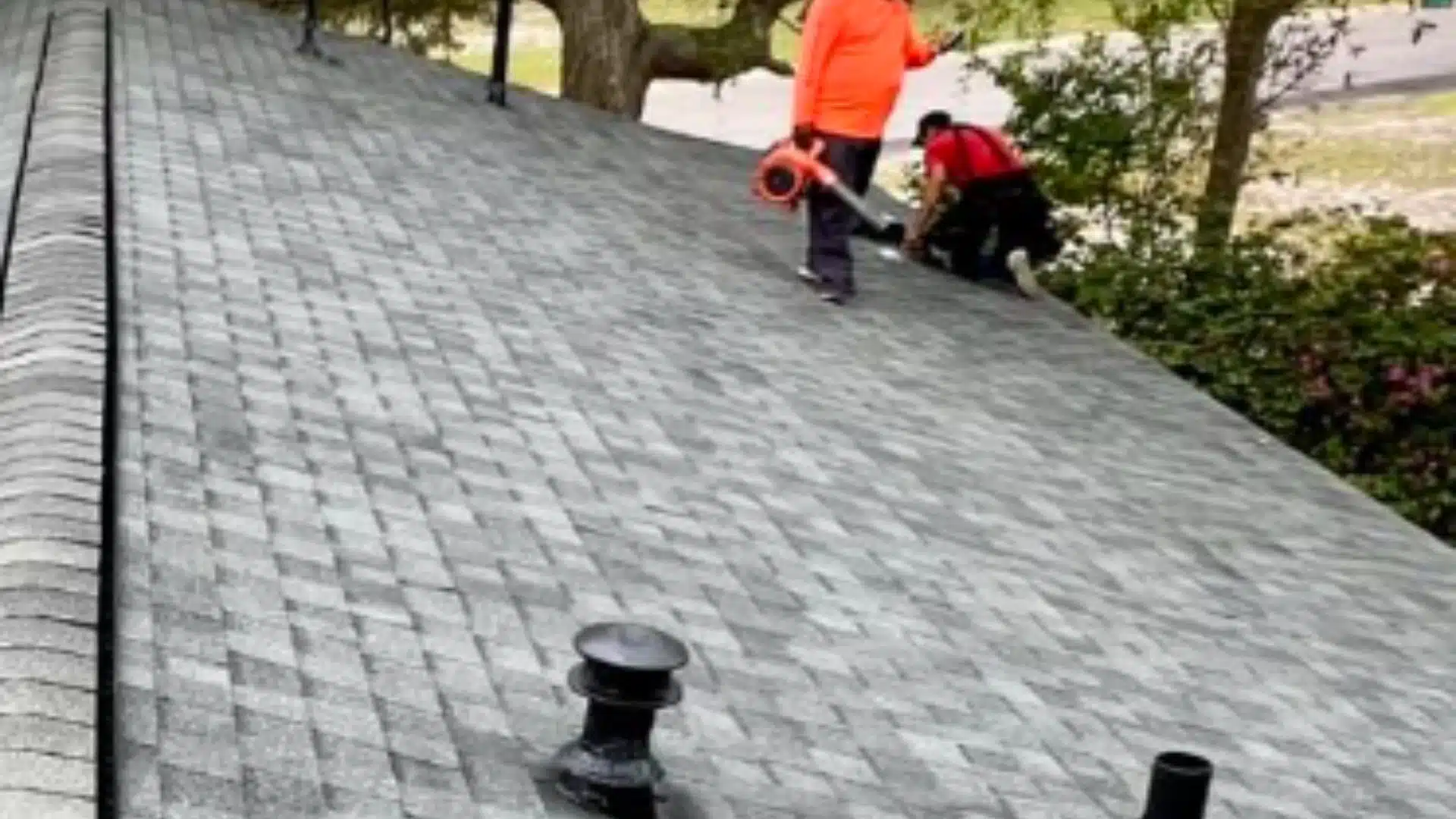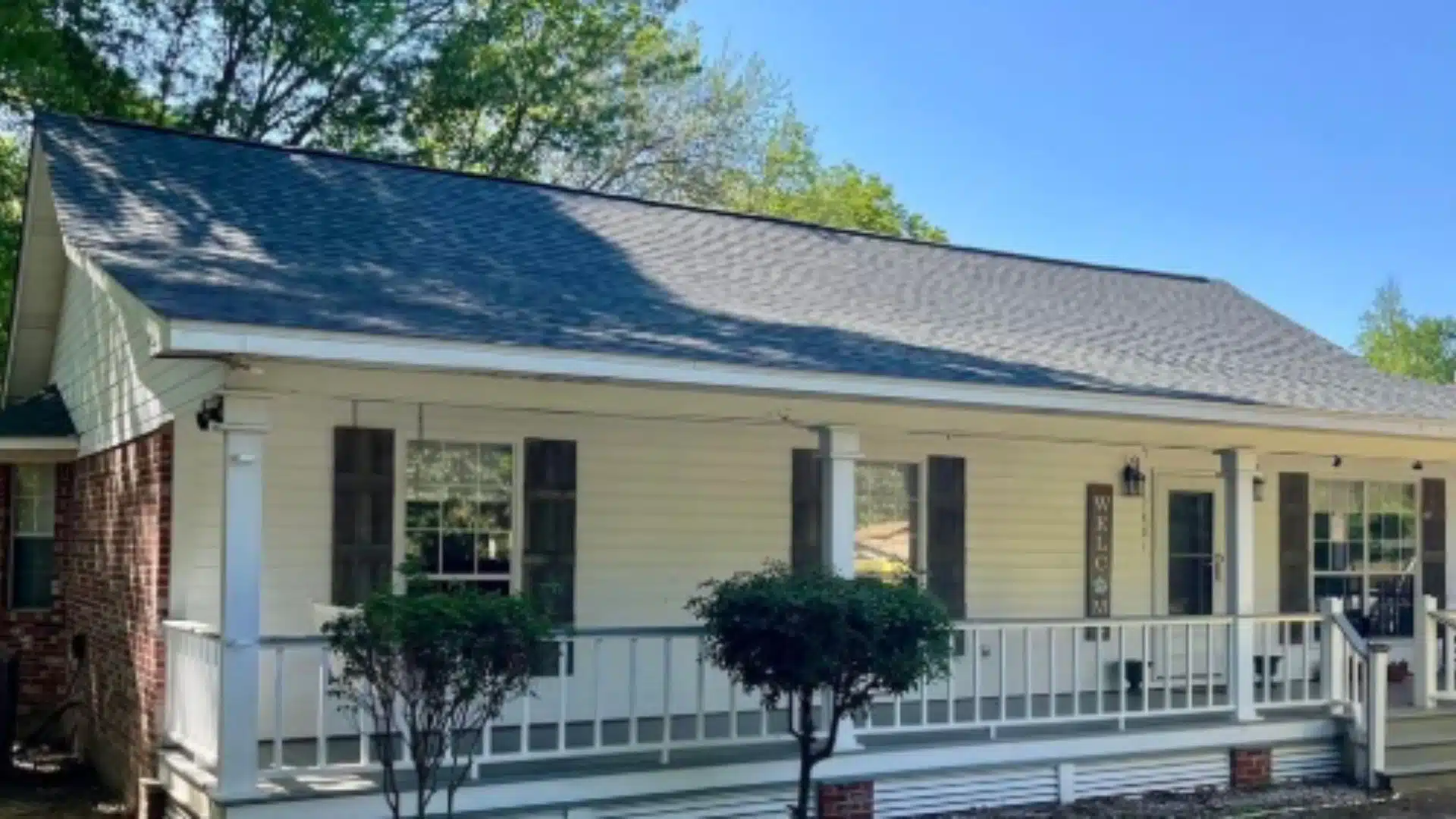Can an existing roof in MS Gulf Coast stand up to the fury of nature without needing a full replacement?
Can an existing roof be fortified? For many homeowners they want to know the answer to this question. The idea of fortifying their roof might seem like an overwhelming, expensive endeavor—something that inevitably involves tearing off the old roof and starting from scratch. However, the truth is that it’s entirely possible to reinforce an existing roof with strategic upgrades. Instead of committing to a costly and disruptive full roof replacement in Gulfport MS retrofitting or fortifying your roof can provide a more practical, affordable solution.
In this blog, we’ll explore how retrofitting, or fortifying, an existing roof can significantly enhance its ability to withstand the forces of nature. Whether it’s high winds, hurricanes, or hail, fortification offers a way to improve your roof’s storm resilience without the need for a complete overhaul. This approach can not only protect your home but also save you money in the long run, making it a smart choice for many homeowners.
What is Roof Fortification?
Definition of Roof Fortification
Roof fortification, also known as retrofitting, is the process of reinforcing and upgrading various elements of your existing roof to make it more resistant to severe weather. This does not necessarily require a full roof replacement; instead, it involves focusing on key areas of the roof that are vulnerable during storms. These upgrades can include strengthening the roof deck, reinforcing connections between the roof and walls, and adding impact-resistant materials—steps that can significantly improve your roof’s storm resistance.
Benefits of Fortifying a Roof
There are numerous advantages to fortifying your roof, starting with enhanced protection against severe weather conditions. A fortified roof is better equipped to handle high winds, heavy rain, and even hail, preventing costly damage to your home. Beyond the immediate storm protection, fortification can also extend the lifespan of your roof, ensuring it remains durable and reliable for years to come. Additionally, many homeowners may find that fortifying their roof can lead to reduced insurance premiums, as it lowers the risk of severe damage during storms. Ultimately, fortifying your roof is a cost-effective way to increase your home’s resilience and longevity.
Key Steps to Fortify an Existing Roof in Ms Gulf Coast
1. Strengthen Roof Deck Attachment
To improve your roof’s resistance to high winds, it’s essential to secure the roof deck and rafters more effectively. One way to achieve this is by applying construction adhesive along the intersection of the roof deck and rafters. This helps enhance the uplift resistance, ensuring that the roof deck stays in place even during extreme wind events.
Additional Tip: For even more durability, opt for ring-shank nails instead of smooth nails. Ring-shank nails have a better grip, helping to nearly double the strength of the roof against wind forces, especially during storms.
2. Seal the Roof Deck
Sealing the roof deck is another crucial step in fortifying an existing roof. Apply specialized adhesives or underlayment along the seams of the roof deck to prevent water from seeping in if the roof covering is damaged or blown off.
Why It’s Important: This step is vital for achieving FORTIFIED Roof™ certification, which sets the standard for roofs that can withstand severe weather. Sealing the deck ensures that even if the roofing material is compromised, water won’t infiltrate the underlying structure, minimizing the risk of water damage to the home.
3. Reinforce Roof-to-Wall Connections
To prevent the roof from being lifted off during extreme winds, it’s essential to securely connect the roof structure to the walls of the home. Installing hurricane straps or clips at the roof-to-wall connection point helps anchor the roof more firmly to the house.
Implementation Options: While it’s easier to do this during a full roof replacement, retrofitting can be accomplished from the attic or behind soffit panels. This makes it possible to reinforce existing roofs without the need for complete removal.
4. Secure Roof Edges
The edges of your roof are particularly vulnerable during high winds, which can cause them to lift and tear away from the structure. To prevent this, use a wider drip edge and fully adhered starter strips along the roof’s edges.
Description: These features help lock down the roof’s perimeter, ensuring that the edges stay in place even during severe weather conditions, protecting the roof from being compromised.
5. Upgrade Roofing Materials
In areas that are prone to hail, it’s essential to upgrade roofing materials to those designed to withstand larger impacts. Installing impact-resistant shingles can significantly improve your roof’s ability to survive hail storms without sustaining damage.
Description: These shingles meet or exceed the Insurance Institute for Business & Home Safety (IBHS) Hail Impact Ratings and are tested to withstand hailstones up to 2 inches in diameter, providing added protection during severe weather.
6. Brace Gable Ends
The gable ends of a roof are particularly vulnerable to high winds and can easily collapse if not properly reinforced. To prevent this, add diagonal bracing to the gable end walls and tie them back to the interior trusses.
Description: This bracing helps prevent the roof’s gable ends from being pushed out during windstorms, keeping the structure intact and avoiding potential damage.
7. Maintain and Repair Regularly
No amount of fortification will be effective if the roof isn’t properly maintained. Regularly inspecting the roof for any loose or damaged shingles, flashing, or gutters is essential to ensure that the fortification remains intact and functional.
Description: By keeping up with repairs and addressing minor issues as they arise, homeowners can prolong the life of their fortified roof and ensure it continues to provide protection against severe weather for years to come.
The FORTIFIED Roof™ Program
What is FORTIFIED Roof™ Certification?
The FORTIFIED Roof™ program, developed by the Insurance Institute for Business & Home Safety (IBHS), is designed to set a benchmark for roofs that are reinforced to better withstand high winds, hurricanes, and other severe weather events. The program involves a series of upgrades and inspections that elevate a roof’s storm resistance to a level that exceeds typical building codes.
Why It Matters: Obtaining FORTIFIED Roof™ certification offers homeowners the peace of mind that their roof has been tested and verified to provide superior protection. Furthermore, homeowners who invest in a FORTIFIED roof may be eligible for insurance discounts due to the reduced risk of damage during storms. Additionally, a FORTIFIED Roof™ can enhance the home’s value, making it a valuable long-term investment.
Key FORTIFIED Roof™ Steps:
- Re-nail the roof deck with ring-shank nails: This ensures that the deck remains firmly attached to the roof structure.
- Seal the roof deck: A crucial step in preventing water damage by sealing seams with adhesive or underlayment.
- Lock down roof edges with a drip edge and starter strip: These elements secure the roof edges and prevent them from being lifted by strong winds.
Additional Considerations: In some cases, spray polyurethane foam insulation can be used to meet multiple FORTIFIED requirements in a single application. This is particularly helpful when the existing underlayment is insufficient for meeting the program’s standards.
Cost and Incentives for Retrofitting
Cost Efficiency of Retrofitting:
Retrofitting an existing roof is often a more cost-effective solution compared to a full roof replacement. While a roof replacement in Gulfport MS typically involves tearing off the old materials, disposing of them, and installing a completely new system, retrofitting focuses on reinforcing key elements of the existing structure. This means you’re not only saving on materials and labor but also minimizing the disruption to your daily life. Retrofitting allows homeowners to enhance the strength and durability of their roofs at a fraction of the cost of replacing the entire roof. In many cases, homeowners can fortify their roofs with strategic upgrades, ensuring better protection against storms without the substantial financial burden of a complete tear-off and rebuild.
Incentives and Grants:
Several states offer programs that provide financial assistance to homeowners looking to retrofit their roofs. Programs like Strengthen Alabama Homes help homeowners offset the cost of roof fortification by offering grants and other financial incentives. These programs are designed to make storm-resistant roofing more accessible to homeowners, especially in areas prone to severe weather like hurricanes and high winds. Other states, such as North Carolina, South Carolina, and Louisiana, have similar initiatives to encourage the adoption of FORTIFIED roofing systems. By taking advantage of these grants and incentives, homeowners can reduce the cost of retrofitting and make their homes more resilient against future storms.
Professional Assessment and Certification

The Need for a Professional Assessment:
While it’s possible to retrofit a roof with DIY solutions, it’s highly recommended to seek a professional inspection from a roofing contractor in MS Gulf Coast before starting any fortification process. A professional roofer in Gulfport MS or structural engineer can assess the current condition of your roof and identify areas that require reinforcement. This assessment ensures that the retrofitting process is tailored to your roof’s unique needs and will effectively improve its performance in severe weather conditions. Additionally, an expert evaluation helps prioritize the most critical upgrades, whether it’s strengthening the roof deck, securing the roof edges, or adding hurricane straps. Professional guidance guarantees that the fortification work will be done properly, ensuring long-term effectiveness.
How to Obtain FORTIFIED Certification:
To achieve FORTIFIED Roof™ certification, homeowners must first ensure their roof meets the rigorous standards set by the Insurance Institute for Business & Home Safety (IBHS). The process begins with a comprehensive inspection by a FORTIFIED Evaluator™—a trained professional who will evaluate the roof’s structure and determine whether it meets the criteria for certification. Once the evaluation is complete, necessary upgrades and retrofitting can be done to meet FORTIFIED standards. After all upgrades are completed, a final inspection by a certified evaluator will verify that the roof meets all requirements. If the roof passes, homeowners will receive FORTIFIED Roof™ certification, which can result in reduced insurance premiums and improved storm protection.
In conclusion, fortifying an existing roof is not only possible, but it’s also a smart and cost-effective way to enhance your home’s protection against severe weather. With the right techniques and strategic upgrades—such as strengthening roof attachments, sealing the deck, and reinforcing roof-to-wall connections—homeowners can significantly improve their roof’s ability to withstand high winds, hurricanes, and hail. Fortifying your roof can extend its lifespan, reduce the risk of damage, and even lead to lower insurance premiums.
If you’re considering fortifying your roof, now is the perfect time to take action. Schedule a professional roof inspection in Gulfport MS to assess the current condition of your roof and determine which fortification methods would work best for you. Not only will you be increasing the safety and durability of your home, but you’ll also be investing in long-term peace of mind. With the potential to reduce damage costs and boost your home’s value, roof fortification is a win-win. Don’t wait for the next storm—fortify your roof today!
FAQ: Fortifying an Existing Roof
1. Can I fortify my existing roof without replacing it?
Yes, fortifying an existing roof typically involves retrofitting it with key upgrades such as reinforcing the roof deck, sealing the seams, and securing the roof edges. These improvements can enhance the roof’s storm resistance without requiring a full replacement.
2. What are the benefits of fortifying my roof?
Fortifying your roof increases its ability to withstand severe weather, such as high winds, hurricanes, and hail. It can also extend the life of your roof, reduce the risk of damage, and potentially lower your insurance premiums, making it a cost-effective investment in your home’s long-term resilience.
3. How do I know if my roof qualifies for fortification?
To determine if your roof qualifies for fortification, it’s essential to have a professional inspection. A certified roofer or structural engineer can assess your roof’s current condition and recommend the appropriate fortification measures based on your roof type and the specific weather risks in your area.
4. What is the FORTIFIED Roof™ certification, and how does it benefit me?
The FORTIFIED Roof™ certification, developed by the Insurance Institute for Business & Home Safety (IBHS), sets standards for roofs that are reinforced to withstand severe weather. Earning this certification can lead to insurance discounts, increase your home’s value, and provide peace of mind knowing your roof has been upgraded for maximum storm protection.
5. Are there any financial incentives for retrofitting my roof?
Yes, several states offer financial incentives and grants to help offset the cost of retrofitting your roof. Programs like Strengthen Alabama Homes and similar initiatives in other states can assist with funding roof fortification, making it more affordable for homeowners to enhance their roof’s storm resistance.




